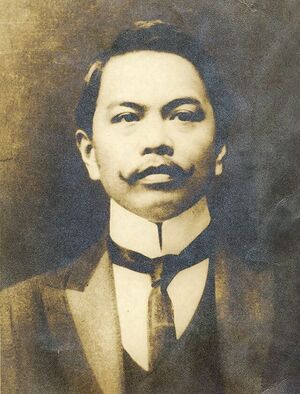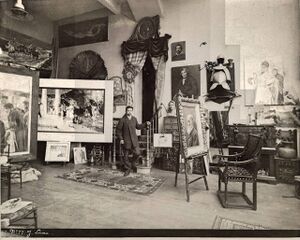Hymen, oh Hyménée! (found Juan Luna painting; 1887): Difference between revisions
mNo edit summary |
PHTVArchive (talk | contribs) No edit summary |
||
| Line 17: | Line 17: | ||
One of his notable works is the Spoliarium, a painting that depicts the dying Roman gladiators and also depicts the despair and death of Filipinos during the Spanish colonization. | One of his notable works is the Spoliarium, a painting that depicts the dying Roman gladiators and also depicts the despair and death of Filipinos during the Spanish colonization. | ||
Juan Luna also has a fair share of lost paintings and letters. One of his paintings, "A Do… Va La Nave?" was found in 2015 after it was emailed to Salcedo Auctions. Two of his paintings, "Aesop after Velasquez", was found in 2014, and "A Farm House", found in 2015 both by Salcedo Auctions.<ref> [https://www.esquiremag.ph/culture/recovering-juan-luna-s-lost-paintings-and-letters-a1729-20180119-lfrm3 How a Mysterious Letter Led to Juan Luna's Lost Paintings and Letters] Retrieved 11 Jun '23</ref> | Juan Luna also has a fair share of lost paintings and letters. One of his paintings, "A Do… Va La Nave?" was found in 2015 after it was emailed to Salcedo Auctions. Two of his paintings, "Aesop after Velasquez", was found in 2014, and "A Farm House", found in 2015 both by Salcedo Auctions.<ref> [https://www.esquiremag.ph/culture/recovering-juan-luna-s-lost-paintings-and-letters-a1729-20180119-lfrm3 How a Mysterious Letter Led to Juan Luna's Lost Paintings and Letters] Retrieved 11 Jun '23</ref> The Pardo de Tavera family, Luna's wife family whom he killed due to jealousy, reportedly destroyed several of his paintings. | ||
== The Painting == | == The Painting == | ||
Described to be a prized personal work of Juan Luna, the painting depicts a Roman wedding feast. It is also speculated that the painting mirrors his own wedding of his wife, Paz Pardo de Tavera, daughter of the Grand Inquisitor of Spain, as there was a heated disapproval due to their different social status and “races.” | Described to be a prized personal work of Juan Luna, the painting depicts a Roman wedding feast. It is also speculated that the painting mirrors his own wedding of his wife, Paz Pardo de Tavera, daughter of the Grand Inquisitor of Spain, as there was a heated disapproval due to their different social status and “races.” | ||
It was most likely finished at 1887. It became Juan Luna’s favorite and displayed at his Paris studio and not meant for public viewing. Nonetheless, he submitted it at the 1899 Paris Exposition Universelle, also known as the 1899 Paris World’s Fair. Due to Luna’s popularity, he was allowed to exhibit his paintings, but due to a variety of reasons he is not allowed to display the paintings he want to exhibit. Instead, he submitted “Hymen, oh Hyménée!” The painting won the bronze medal. | It was most likely finished at 1887. It became Juan Luna’s favorite and displayed at his Paris studio and not meant for public viewing. Nonetheless, he submitted it at the 1899 Paris Exposition Universelle, also known as the 1899 Paris World’s Fair. Due to Luna’s popularity, he was allowed to exhibit his paintings, but due to a variety of reasons he is not allowed to display the paintings he want to exhibit. Instead, he submitted “Hymen, oh Hyménée!” The painting won the bronze medal. | ||
The painting was in Luna’s possession until he died of cardiac arrest in 1899. The painting then vanished.<ref name="inquirer"> [https://newsinfo.inquirer.net/1782789/long-lost-luna-greatest-ph-art-find-in-history Long-lost Luna ‘greatest PH art find in history’] Retrieved 11 Jun '23</ref> | The painting was in Luna’s possession until he died of cardiac arrest in 1899. The painting then vanished.<ref name="inquirer"> [https://newsinfo.inquirer.net/1782789/long-lost-luna-greatest-ph-art-find-in-history Long-lost Luna ‘greatest PH art find in history’] Retrieved 11 Jun '23</ref> | ||
Revision as of 13:27, 11 June 2023
“Hymen, oh Hyménée!” or Roman Wedding, is a painting of Filipino painter Juan Luna. The painting won the bronze medal at the 1889 Paris World’s Fair.
Described as the “holy grail of Philippine art,” the painting disappeared after the fair. The painting was found by Jaime Ponce de Leon of the León Gallery after 10 years. It is hailed as the “find of the century.”[1]
Juan Luna
Juan Luna is a known Filipino painter, sculptor, and a political activist of the Philippine Revolution. His brother, Antonio Luna, is a famed general of the Philippine Revolutionary Army which was killed during the war.
One of his notable works is the Spoliarium, a painting that depicts the dying Roman gladiators and also depicts the despair and death of Filipinos during the Spanish colonization.
Juan Luna also has a fair share of lost paintings and letters. One of his paintings, "A Do… Va La Nave?" was found in 2015 after it was emailed to Salcedo Auctions. Two of his paintings, "Aesop after Velasquez", was found in 2014, and "A Farm House", found in 2015 both by Salcedo Auctions.[2] The Pardo de Tavera family, Luna's wife family whom he killed due to jealousy, reportedly destroyed several of his paintings.
The Painting
Described to be a prized personal work of Juan Luna, the painting depicts a Roman wedding feast. It is also speculated that the painting mirrors his own wedding of his wife, Paz Pardo de Tavera, daughter of the Grand Inquisitor of Spain, as there was a heated disapproval due to their different social status and “races.”
It was most likely finished at 1887. It became Juan Luna’s favorite and displayed at his Paris studio and not meant for public viewing. Nonetheless, he submitted it at the 1899 Paris Exposition Universelle, also known as the 1899 Paris World’s Fair. Due to Luna’s popularity, he was allowed to exhibit his paintings, but due to a variety of reasons he is not allowed to display the paintings he want to exhibit. Instead, he submitted “Hymen, oh Hyménée!” The painting won the bronze medal.
The painting was in Luna’s possession until he died of cardiac arrest in 1899. The painting then vanished.[3]
The Search
The painting was either theorized to have been destroyed during the Philippine Revolution, burned by Pardo de Tavera family after Luna killing his wife in 1892, or sold to a French museum. Although, there were surviving black and white photographs that briefly included the painting, along with sketches on Luna’s old paintings.[3][1]
In the 1970s, Filipino collector Dr. Eleuterio “Teyet” Pascual was invited to view the art collection of an “aristocratic family in Europe.” Pascual saw the painting in the family’s art collection, as the painting was sold to the family in the 1920s. He tried to buy the painting, but the painting was not for sale. Another collector also tried to buy it 20 years later, but failed.[3]
The search was then again undertaken by Jaime Ponce de Leon of the León Gallery, an art collector. The search nearly taken ten years until in 2014 when he was instructed to be at the home of the “aristocratic family”. This time, the family is ready to sell and would be the most expensive Leon bought. It took until 2017 to complete the purchase.[1]
In 2022, a long-term loan between Leon and Ayala Museum was formalized, and the painting will be displayed on the said museum on June 12 through the multimedia exhibition “Splendor: Juan Luna, Painter as a Hero,” just in time for the 125th Independence Day celebrations.[4]
References
- ↑ 1.0 1.1 1.2 ‘Holy grail’: Juan Luna’s lost masterpiece revealed after 132 years Retrieved 11 Jun '23
- ↑ How a Mysterious Letter Led to Juan Luna's Lost Paintings and Letters Retrieved 11 Jun '23
- ↑ 3.0 3.1 3.2 Long-lost Luna ‘greatest PH art find in history’ Retrieved 11 Jun '23
- ↑ Juan Luna's Long-Lost Painting Revealed After 132 Years Retrieved 11 Jun '23


